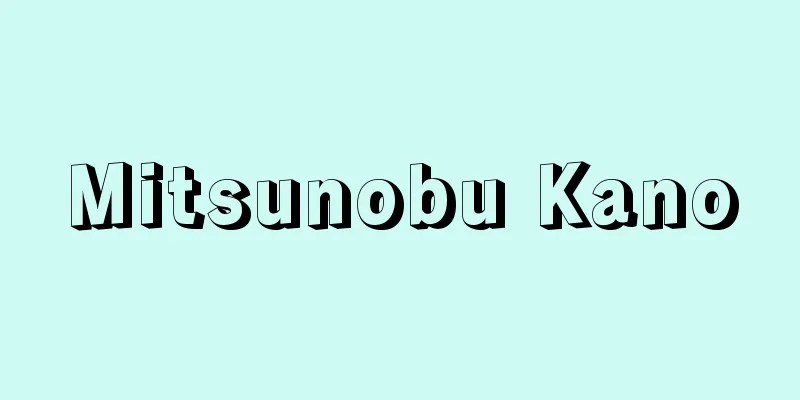Mitsunobu Kano

|
Year of death: June 4, 1608 (July 15, 1608) Year of birth: Unknown. A painter of the Momoyama period. Born in Kyoto as the eldest son of Kano Eitoku. His childhood name was Shirojiro, and he later became known as Ukyo no Shin. His son Sadanobu was also called Ukyo no Shin, and to distinguish him from Sadanobu, he is also known as Old Ukyo. Since Eitoku served Oda Nobunaga, it is assumed that Mitsunobu also worked on the creation of the screen paintings for Azuchi Castle at a young age. He also served Toyotomi Hideyoshi, and is thought to have worked with his father on screen paintings for Osaka Castle and Jurakudai Castle. After Eitoku's death, he became the center of the Kano school, and created screen paintings for Nagoya Castle in Hizen (Saga Prefecture) (1592). He also painted folding screens at the Imperial Court (1598), screen paintings for the guest hall of Kangakuin Temple at Shiga Onjoji Temple (1600), and a painting of the Imperial Palace (1603) for the residence of Tokugawa Hidetada (Nijo Castle) in Kyoto, but few of his works remain. He went down to Edo (1606) by order of the Edo Shogunate, but died in Kuwana (Mie Prefecture) on his way back to Kyoto. He is said to have been 44 years old, or 48 years old. Mitsunobu's style was characterized by more decorative, delicate and elegant expressions, unlike the grandiose and magnificent style of his father Eitoku. The sliding screen paintings at Kan'gakuin Temple in Onjo-ji, Mausoleum of Kodai-ji Temple in Kyoto, Honen-in Temple in Kyoto, and Tsukubusuma Shrine in Shiga, which are said to have been created by Mitsunobu or artists close to him, do not have the grandeur and severity of Eitoku, but have a modest yet deep compositional style and an elegant lyricism typical of Yamato-e painting. Since the Edo period, Mitsunobu has not necessarily been as highly regarded as Eitoku, but in recent years he has been attracting attention as an artist who bridged the gap from the Eitoku style to the Edo Kano style centered on his nephew Tan'yu. <References> Doi Tsuguyoshi, "Kano Eitoku/Mitsunobu" (Complete Collection of Japanese Art Paintings, Volume 9) (Tomoji Ogawa) Source: Asahi Japanese Historical Biography: Asahi Shimbun Publications Inc. About Asahi Japanese Historical Biography |
|
没年:慶長13.6.4(1608.7.15) 生年:生年不詳 桃山時代の画家。狩野永徳の嫡男として京都に生まれた。幼名は四郎次郎,のち右京進と称した。子の貞信も右京進と称され,それと区別して古右京とも呼ばれている。永徳が織田信長に仕えたところから,光信も年少のうちに安土城障壁画の制作に従事したと推定される。また豊臣秀吉にも仕え,父と共に大坂城や聚楽第にも障壁画を描いたと思われる。永徳の没後は狩野派一門の中心となり,肥前(佐賀県)名護屋城の障壁画を制作した(1592)。その他,宮中で屏風(1598)を,滋賀園城寺勧学院客殿に障壁画(1600)を,京都の徳川秀忠邸(二条城)に大内裏図(1603)などを描いたが,現存作は少ない。江戸幕府の命で江戸へ下向したが(1606),帰洛の途次,桑名(三重県)で客死した。享年44歳,また48歳ともいう。光信の作風は,父永徳の豪壮華麗な様式とは異なり,より装飾化された繊細優美な表現を特色とする。光信あるいはその周辺作家の作とされる園城寺勧学院,京都高台寺霊屋,京都法然院,滋賀都久夫須麻神社などの障壁画には,永徳の雄大さと厳しさはないが,慎ましやかながら奥行きのある構図法に,やまと絵的な優美な抒情性がある。江戸時代以来,光信の評価は永徳と比べ必ずしも高くないが,近年,永徳様式から甥の探幽を中心とする江戸狩野様式への橋渡しをした作家として注目されつつある。<参考文献>土居次義「狩野永徳/光信」(『日本美術絵画全集』9巻) (小川知二) 出典 朝日日本歴史人物事典:(株)朝日新聞出版朝日日本歴史人物事典について 情報 |
Recommend
The Golden Ball in the Palm of Your Hand - Kingyokushochusho
A commentary on the ancient criminal code, the Rit...
Kikyouya Kawachi - Kikyouya Kawachi
...The "Gozen Kashi Hidensho" (1718) st...
Inman, GE (English spelling) InmanGE
...The halogen light bulb filled with iodine was ...
Mathura Art - Mathura Art
Art that flourished during the Kushan and Gupta pe...
Cabora Bassa Dam
…It enters Mozambique, turns from east to southea...
Louis Philippe
1773‐1850 The last king of France. Reigned 1830-48...
Iide [town] - Iide
A town in Nishiokitama County in the southwest of ...
Samos [island] - Samos
An island in the Sporades archipelago in the easte...
Asura - Asura
Please see the Ashura page. Source: Encyclopaedia...
Yishui
A county in the southeastern part of Shandong Prov...
Exekias
Ancient Greek potter and pottery painter. Active f...
Li Zong-ren (English spelling)
[Live] Guangxu 16 (1890).9.16. Guangxi, Guilin Die...
Interest group
...Morgan (the Morgan family) and the Rockefeller...
Auxotrophic mutants - Auxotrophic mutants
…The types of substances required vary from speci...
Utoumen (English spelling) wū tóu men
A Chinese gate with two pillars connected at the t...









